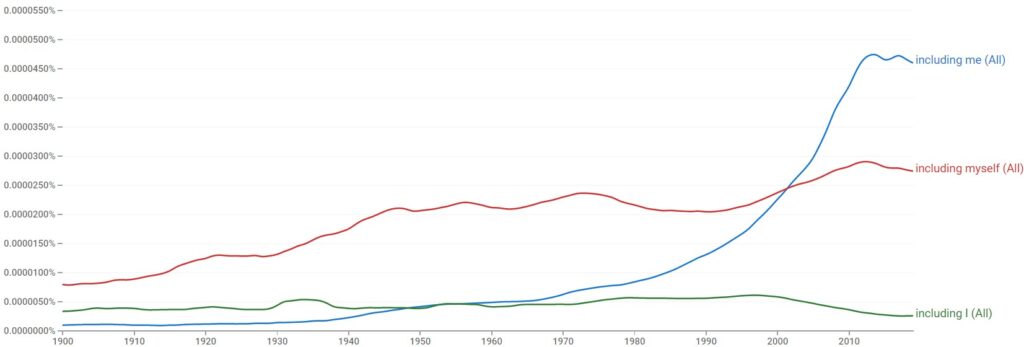You might have seen both “including me” and “including myself” used in texts. Maybe you think the second option sounds smarter and more formal. But English is ever the fickle one, and it turns out most uses of “including myself” are a big no-no.
Including Me vs. Including Myself – What’s the Difference?
“Including me” is correct no matter the subject of the sentence. “Including myself” can only be used if the subject of the sentence is “I” or “me”. Reflexive pronouns like “myself” are used when the subject and object of the sentence are the same, for emphasis or in absolute constructions.

So, a technically incorrect use would be like this:
- Incorrect: All South Africans, including myself, have faith in the youth of our country.
Here, “all South Africans” is the subject of the sentence. Neither the pronouns “I” nor “my” have been used prior to the use of “myself”. Therefore, it would be correct to use “including me”:
- Correct: All South Africans, including me, have faith in the youth of our country.
A reflexive pronoun is a compound of any personal pronoun (e.g., my, them, it) with “self/selves”. Here’s an example of how we accurately use them every day. We’ve italicized the subject and object:
- I did it myself!
The compound form is only used when referring back to the same pronoun, which is the subject of the sentence.
Including Me
“Including me” is a phrase that shows that the speaker aligns themselves with a group. It is correct to use “including me” rather than “including myself” when the subject and object of your sentence are different.
Here are some examples of how to use “including me” in a sentence. We have italicized the object and subject in these sentences so you can see how they differ. A sentence will always have a subject but not always an object.
- Including me, there’s going to be 8 people eating at the dinner party.
So, the subject is “me” while the “dinner party” is the object.
- Including me, everyone hated the food at the dinner party!
Here, both “everyone” and “me” are subjects. The action these two subjects are taking is the verb component of the sentence (“hated”) and the thing they are acting against (“the food”) is the object.
- Everyone was crying, including me.
Now, “everyone” and “me” are both still subjects but there is no object in this sentence, there is only the verb action that the two subjects are performing – crying.
Let’s bring an object back into the sentence just to clearly illustrate this:
- Everyone was crying about how bad my food was, including me.
In all these instances, “including me” is used correctly.
Including Myself
“Including myself” means the same thing as “including me”: a speaker aligning themselves with a group. It should be used in place of “including me” when part of a sentence where the subject is “I” or “me”, otherwise it is technically incorrect.
Here are some examples of how to correctly use “including myself” in a sentence. In all of these examples, both the subject and the object of the sentence will be the same. We have italicized the object and subject in these sentences so you can see this:
- I have no faith left in anyone, including myself.
The “I” in the sentence is the subject. This is the person performing the action of the sentence, which is “having no faith”. Those who are not being deemed worthy of faith (“anyone” and “myself”) are the objects.
Get it? Let’s have a look at some more examples. We’ve skipped the italics here so that you can try and identify the subjects and objects on your own:
- My personality is abrasive to everyone, including myself.
- I don’t think anyone likes my cooking, including myself.
- My list of enemies, including myself, has now reached 53.
Including I
It is incorrect to use the phrase “including I”. This is because “including” is a preposition and needs to be followed by an object. The objective case of the personal pronoun is “me” – therefore, the correct phrase is “including me”.
Here is an example of how you shouldn’t use “including I” in a sentence:
- Incorrect: Including I, there will be five people in the car.
It should instead be:
- Correct: Including me, there will be five people in the car.
Which Is Used the Most?
“Including me” is currently used the most, as we can see on the Google Ngram Viewer. However, despite only being correct in specific cases, “including myself” was previously more popular up until 2002!

Despite being wrong, “including I” has also managed to maintain a steady (if low) level of use over the years. Great evidence that we should never let our lack of skill hold us back from pursuing our dreams!
Final Thoughts
It is only appropriate to use “including myself” when a speaker is discussing themselves, so both the subject and object of the sentence are the same. In other cases, “including me” is the correct term. It is never appropriate to say “including I”, as “me” is the objective form.

Martin holds a Master’s degree in Finance and International Business. He has six years of experience in professional communication with clients, executives, and colleagues. Furthermore, he has teaching experience from Aarhus University. Martin has been featured as an expert in communication and teaching on Forbes and Shopify. Read more about Martin here.
